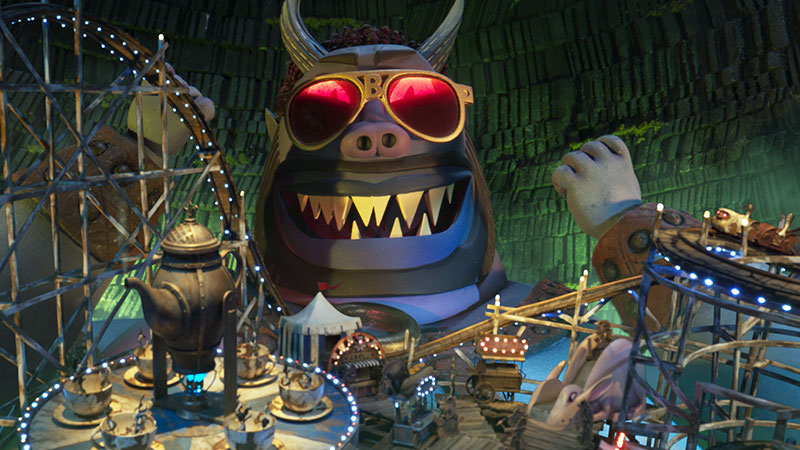VFX Supervisor Richard Frazer talks about creating Britain in the Dark Ages – building and animating armies engaged in intense battle with realistic environments and crowd replication.

The team at BlueBolt has delivered the VFX for ‘Seven Kings Must Die’, serving as sole vendor for the Netflix feature film that concluded the historical drama series ‘The Last Kingdom’. Seven Kings Must Die is the final chapter of the story of Uhtred of Bebbanburg as he rejoins his comrades and attempts to unite England following the death of King Edward, as both invaders and rival heirs battle for the crown.
The movie marks a significant conclusion for BlueBolt as well, after the team took the same role for all five seasons of the show. 'The Last Kingdom: Seven Kings Must Die' is now also an entry in AEAF Awards in the TV Series category.
Making History
BlueBolt re-created the world of Britain in the Dark Ages, the setting of the story, portraying the dramatic life of Uhtred of Bebbanburg. Uhtred is a real historical figure, as well as the protagonist of ‘The Saxon Stories’, the novels by Bernard Cornwell that the show is based on. In total, the team completed over 3,500 VFX shots over the show’s eight year run, working alongside the producers at Carnival Films and the director Edward Bazalgette.
Led by VFX Supervisor Richard Frazer, who also supervised the VFX work for seasons three, four and five of The Last Kingdom, BlueBolt created and choreographed large, complex CG battle scenes and army formations. Across the movie, their shots called for CG horses, historically accurate CG ships and elaborate environments. Their work included transforming the production’s Budapest location into 10th century Britain, and recreating Uhtred’s ancestral home at Bebbanburg Castle in Northumberland. They also visualised the legendary hall of Valhalla in the final scenes of the film.
All of this work was essential to building an authentic world representing those times in Northumbria, marked by a treacherous, bloody succession of rulers and battles, and making those historical characters feel real to the audience.
Setting the Look
Richard Frazer talked about the team’s approach to their work on the project. “We rely on the Production Designer, art department and costume department to set the look of the show – all of our CG characters and environments take their lead from these designs,” he said. “We also have a historical consultant who gives feedback on period authenticity, but we always go through a pragmatic weighing up of how strictly to adhere to this. The creative needs of the show need to be met – after all, we are creating entertainment rather than a documentary.

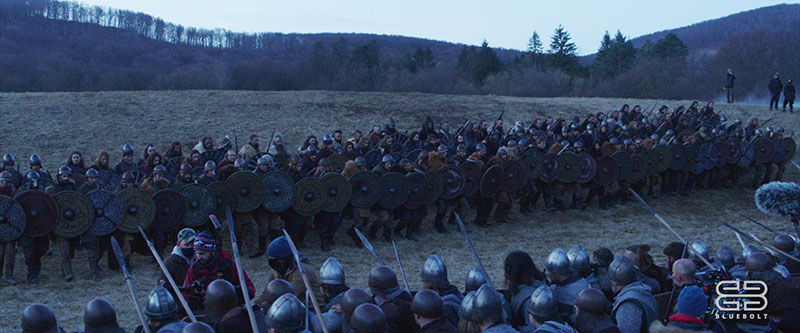
“For example, in the final film, BlueBolt undertook one of the biggest battle scenes we’ve ever created for the series. Because it involved several different armies, their distinctive uniforms and livery needed to be readable and distinguishable when seen in wide aerial shots of the battlefield.”
Crowd Control
Crowd replication is one of the key areas in which the VFX team has always helped out on the show. Over time, their creation, management and control of crowds has advanced. “Although we shot the battles out in Hungary using hundreds of supporting actors, it was impossible to hire and direct the thousands of real people that we would have needed to correctly populate the battle,” Richard said.
“In earlier seasons we would move the crowd around in groups and shoot multiple passes, and later composite these plates together to multiply the numbers of people. However, in later seasons we have relied more and more on fully CG characters to bulk out the armies.”

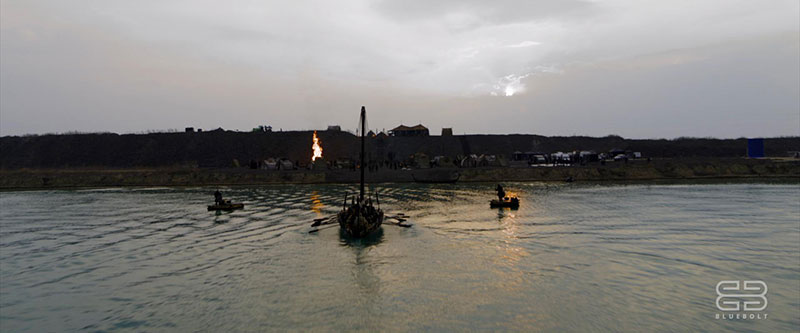
In the final film 'Seven Kings Must Die', it was an important plot point that the soldiers of the two opposing sides were crushed together, working in various shield wall formations, and slowly rotated around to expose their flank for a pincer attack. The production attempted to shoot the sequence in wide aerial shots with the real actors, but it simply became too difficult to choreograph.
Richard said, “In the end, I requested that the drone team shot plates of the empty battlefield that we could populate with fully CG armies. This would give us complete control over the intricate manoeuvring, as well as making sure the audience could easily distinguish each side visually.
Bespoke Motion Data
“To do this, we also needed motion data for our CG soldiers. We had invested in a couple of motion capture suits at the beginning of season 5, deciding to go with inertia based suits so that we weren’t tied to a dedicated studio space. The suits allowed us to capture fighting actions with our stunt performers when we were on site in the Hungarian countryside, giving us a mix of custom individual actions, such as a sword slash, that could be triggered by the crowd simulation software, or a full one-on-one choreography that we could dress in among the battle action.”
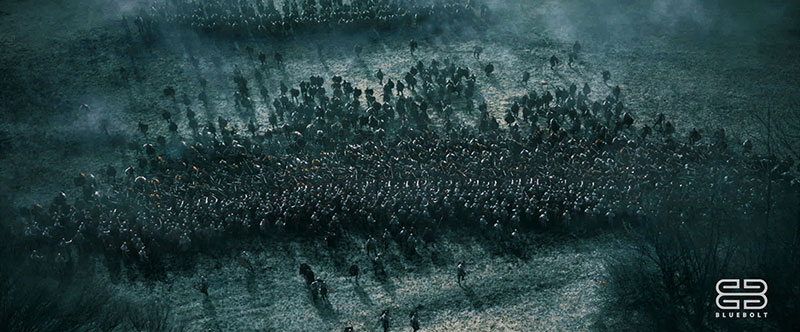
The BlueBolt team found that working this way opened up a much higher level of flexibility for how they created crowds, including when the opposing sides were pushed together in the shield walls. If they needed anything further after the shoot had wrapped, they would take turns capturing further bespoke actions back at London office.
Even so, the scene still stretched the capabilities of their crowd simulation software, Golaem. “It works really well, but isn’t really designed to have its characters crushed up against each other and pushing each other out of the way," Said Richard. "Our crowd TD team did a great job of simulating the crowd as far as possible, but would then need to go in and clean up all of the intersections by hand.”
More Battles to Come
At times, the CG characters would also be very close to camera, but their library of assets is now so lifelike and libraries of motion capture data are so extensive that they can use them alongside real actors. “One of our crowd TDs, Michael Ercolano, helped build a lot of custom tools for managing and organising the huge number of files. We aim to have a full, dedicated library for motion capture data that could then potentially be reused on other shows. Working on ‘The Last Kingdom’ has taught us a lot about simulating large scale crowds, so I hope we get to use that knowledge on future projects soon," Richard said.
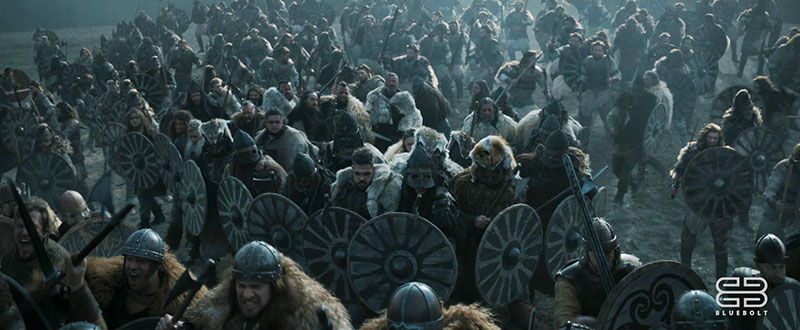

“Because we’ve been involved with ‘The Last Kingdom’ since the very beginning, a lot of our artists have also developed along with it over the seasons, so there is a genuine love for the project. The team’s Head of Digital Matte Painting Tamara Toppler, for instance, is also a huge fan of the show and an expert on the Dark Ages period of British history. She has been instrumental in designing the CG environments and habitations and always gave us great input on the authenticity of the designs.
“Even after all these years, working on ‘The Last Kingdom’ has continued to feel fun and exciting. For ‘Seven Kings Must Die’, everyone produced some of their best work to give Uhtred an ideal send-off.”
Seven Kings Must Die and all five seasons of The Last Kingdom are currently streaming on Netflix. www.blue-bolt.com
Words: Adriene Hurst

















